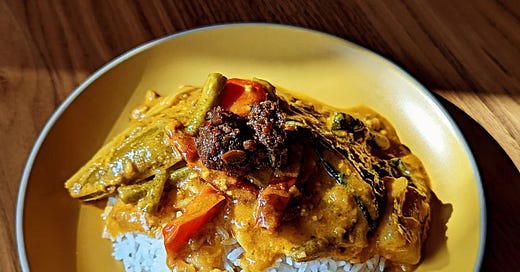Autumn is here. I’m back from the dead. Pumpkins are abound; leaves are turning; Thanksgiving is in the air. So it’s time for stew, right? Especially if it’s orange colored.
Kare-kare (literally curry-curry in Filipino) is an achuete-hued traditional stew. Despite the name, it shares very little with Indian curry except the color. But it does share the the same warm, luscious, hearty, and comforting qualities of a good curry. Perfect fall weather food. Perfect on a bed of white rice.
Peanuts play the lead role (apologies to those allergic) here, adding a base layer of nuttiness that lifts the supporting cast of assorted vegetables of your choice (okra, eggplants, long beans, spinach, cabbage, carrots are classics). It has your heavy hitter Filipino aromatics: lots of garlic, bay leaves, ginger, black pepper, and dried and fresh chiles. I use a profuse amount of coconut oil here to replace the fat you would usually get from the slow cooked oxtail in the traditional version of the dish. After all, it wouldn’t be kare-kare without that fatty, glossy sheen.
An essential condiment to this dish is bagoong, which is a fermented shrimp or fish paste. I make a vegan one here with doenjang and mushrooms. It delivers a similar umami brininess that really pulls the flavors all together. If you don’t mind having seafood, go ahead a get a jar of traditional bagoong (it works so well in dishes that call for brown miso).
Ingredients
Kare-kare
2 large onions, one whole and unpeeled, the other cut into a large dice
2 bay leaves, fresh or dried
2 teaspoons kosher salt
5 dried Thai chiles
1 cup (170 to 200 g, depending on the brand) rice flour
4 teaspoons finely ground annatto (achuete)
2 teaspoons coarsely cracked black pepper
10 tablespoons coconut oil
1 cup (128 g) coarsely ground peanuts
1 (2-inch/5 cm) piece fresh ginger, peeled and finely minced
8 cloves garlic, smashed and peeled
2 large carrots, cut into large dice
3 whole fresh Fresno or serrano chiles
½ cup (75 ml) fish sauce or vegan fish sauce from my sinigang recipe
½ cup (120 ml) peanut butter (I recommend
1 medium Japanese eggplant, cut into 2 inch pieces
1½ cups/165 g long beans, cut into 3-inch pieces
12 pods okra
1 large red bell pepper, cut into 1-inch dice
½ head small green cabbage, chopped into 2-inch pieces
1 bunch kangkong (water spinach) or spinach
Vegan bagoong
100 grams (about 1/2 lbs) maitake mushrooms, minced
1/2 cup doenjang or brown miso
1 shallot, minced
2 garlic cloves, minced
1 tsp aleppo red peppers flakes
Rice, for serving
Method
Optional: Make the vegan bagoong. Heat a small pan or skillet over medium high heat and add about 2 tbsp of vegetable oil. Once hot, sauté the onions, garlic and red pepper flakes until they are soft and release their aroma (about 3 minutes).Add in the mushrooms and then cook for 3 to 4 minutes. Once the mushrooms are cooked through, add in the soybean or miso paste and then mix it with the mushrooms well. Leave to cook over medium high heat for 3 to 4 minutes until everything is well incorporated. Turn off the heat and leave the paste to cool completely before using and storing1.
Turn a stovetop gas burner to medium high. Cut the whole onion in half and, keeping the skin on, char each half directly on the burner, rotating every 2 minutes, until the onion has blackened2.
Fill a pot with 6 cups of vegetable stock. Add the charred onion halves. Bring to a boil over high heat, then reduce to medium low and simmer with the lid on for 30 mins.
Turn off the heat and set the pot aside. Put a strainer over a bowl or a large glass measuring cup and pour the cooking liquid through the strainer until you have about 5-6 cups of cooking liquid. Discard the onions.
Heat another large pot over medium high. Once hot, add the dried chiles, rice powder/flour, annatto seed, and black pepper. Stir for about 5 minutes, until light brown and fragrant. Add all the coconut oil and ground peanuts until deeply browned (about 3 minutes). Add the ginger, garlic, carrots, diced onion, fresh chiles, fish sauce, and peanut butter, and cook for about 8-10 minutes, stirring occasionally.
Add 5 cups of the strained stock. Then add the eggplant, long beans, okra, bell pepper, and cabbage, and simmer covered for about 30 minutes, until the sauce has thickened and clings to the vegetables. If it’s too thick, add more strained stock (if any), otherwise add 1/2 cup of water at a time until the right consistency.
Before serving, stir in the spinach and bagoong, to taste.
Ladle over warm rice with some of each of the vegetables.
Kaon na ta!
Imong amigo,
Expo
This can keep in the fridge for about 2-3 months in a tightly lid jar.
You can also do this on a grill or in the oven broiler but I find the gas burner method more convenient.




